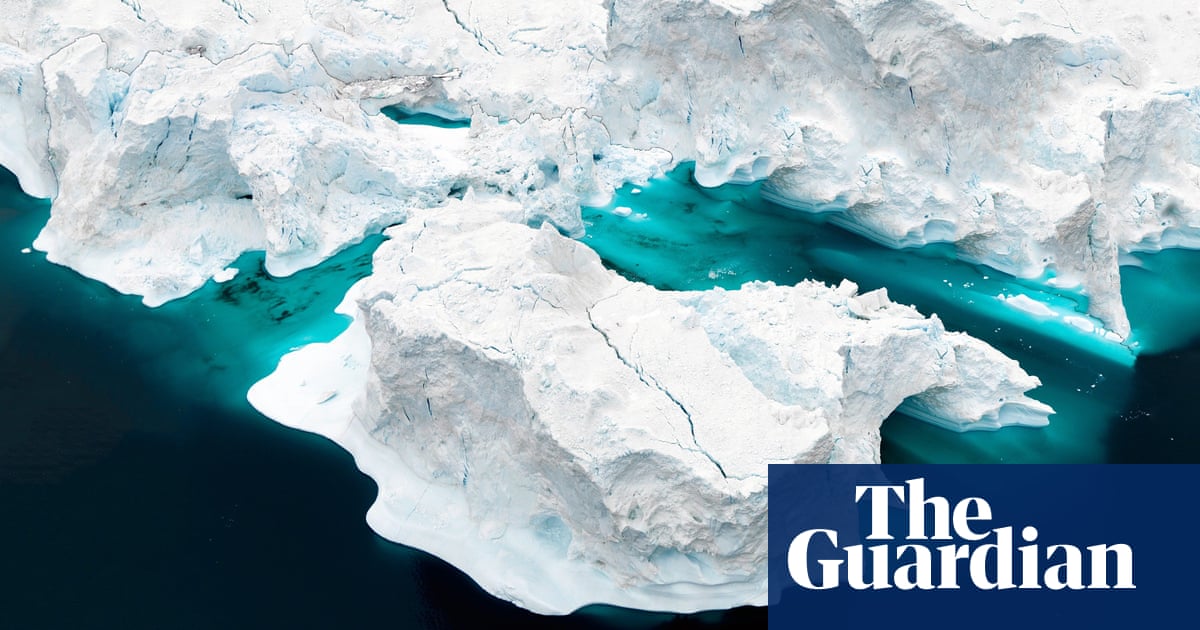
The Greenland ice cap is losing an average of 30m tonnes of ice an hour due to the climate crisis, a study has revealed, which is 20% more than was previously thought.
Some scientists are concerned that this additional source of freshwater pouring into the north Atlantic might mean a collapse of the ocean currents called the Atlantic meridional overturning circulation (Amoc) is closer to being triggered, with severe consequences for humanity.
Major ice loss from Greenland as a result of global heating has been recorded for decades. The techniques employed to date, such as measuring the height of the ice sheet or its weight via gravity data, are good at determining the losses that end up in the ocean and drive up sea level.
However, they cannot account for the retreat of glaciers that already lie mostly below sea level in the narrow fjords around the island. In the study, satellite photos were analysed by scientists to determine the end position of Greenland’s many glaciers every month from 1985 to 2022. This showed large and widespread shortening and in total amounted to a trillion tonnes of lost ice.
“The changes around Greenland are tremendous and they’re happening everywhere – almost every glacier has retreated over the past few decades,” said Dr Chad Greene, at Nasa’s Jet Propulsion Laboratory in the US, who led the research. “It makes sense that if you dump freshwater on to the north Atlantic Ocean, then you certainly get a weakening of the Amoc, though I don’t have an intuition for how much weakening.”
The Amoc was already known to be at its weakest in 1,600 years and in 2021 researchers spotted warning signs of a tipping point. A recent study suggested the collapse could happen as soon as 2025 in the worst-case scenario. A significant part of the Greenland ice sheet itself is also thought by scientists to be close to a tipping point of irreversible melting, with ice equivalent to 1-2 metres of sea level rise probably already expected.
The study, published in the journal Nature, used artificial intelligence techniques to map more than 235,000 glacier end positions over the 38-year period, at a resolution of 120 metres. This showed the Greenland ice sheet had lost an area of about 5,000 sq km of ice at its margins since 1985, equivalent to a trillion tonnes of ice.
The most recent update from a project that collates all the other measurements of Greenland’s ice found that 221bn tonnes of ice had been lost every year since 2003. The new study adds another 43bn tonnes a year, making the total loss about 30m tonnes an hour on average.
The scientists said: “There is some concern that any small source of freshwater may serve as a ‘tipping point’ that could trigger a full-scale collapse of the Amoc, disrupting global weather patterns, ecosystems and global food security. Yet freshwater from the glacier retreat of Greenland is not included in oceanographic models at present.” The influx of less dense freshwater into the sea slows the usual process of heavier salty water sinking in the polar region and driving the Amoc.
Prof Tim Lenton, at the University of Exeter, UK, and not part of the study, said: “This additional freshwater input to the north Atlantic is a concern, particularly for the formation of deep water in the Labrador and Irminger Seas within the subpolar gyre, as other evidence suggests these are the regions most prone to being tipped into an ‘off’, or collapsed state.”
“That would be like a partial Amoc collapse, but unfolding faster and having profound impacts on the UK, western Europe, parts of North America, and the Sahel region, where the west African monsoon could be severely disrupted,” he said. “Whether this previously unaccounted source is enough freshwater to make a difference depends on how close we are to that subpolar gyre tipping point. Recent models suggest it could be close already at the present level of global warming.”
However, Prof Andrew Shepherd, at the University of Northumbria, UK, said: “Although there was a step-change in glacier retreat at the turn of the century, it’s reassuring to see that the pace of ice loss has been steady since then and is still well below the levels needed to disturb the Amoc.”
The discovery of the extra ice loss is also important for calculating the Earth’s energy imbalance, ie how much extra solar heat the Earth is trapping due to human-caused greenhouse gas emissions, said Greene. “It takes a lot of energy to melt 1tn tonnes of ice. So if we want very precise energy balanced models for the Earth, this has to be accounted for.”
The glaciers analysed in the study were mostly below sea level already, so the lost ice was replaced by sea water and did not affect sea level directly. But Green said: “It almost certainly has an indirect effect, by allowing glaciers to speed up. These narrow fjords are the bottleneck, so if you start carving away at the edges of the ice, it’s like removing the plug in the drain.”
Chad and colleagues also analysed the extent of Antarctic ice shelves over time in a study published in 2022. It found that the total lost from the ice shelves since 1997 was doubled to about 12tn tonnes when the shrinking areal extent of the shelves was accounted for and added to the thinning of the shelves.
Article From & Read More ( Greenland losing 30m tonnes of ice an hour, study reveals - The Guardian )https://ift.tt/hj7arSY
Science
No comments:
Post a Comment